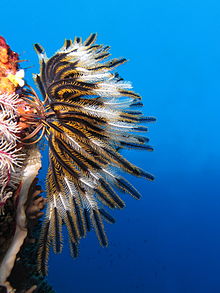Crinoidea
| Crinoids Temporal range: Ordovician - Recent |
|
|---|---|
 |
|
| Crinoid on the reef of Batu Moncho Island, Indonesia | |
| Scientific classification | |
| Kingdom: | Animalia |
| Phylum: | Echinodermata |
| Subphylum: | Crinozoa |
| Class: |
Crinoidea Miller, 1821 |
| Subclasses | |
|
Articulata (540 species) |
|
Articulata (540 species)
†Flexibilia
†Camerata
†Disparida
Crinoids are marine animals that make up the class Crinoidea of the echinoderms (phylum Echinodermata). The name comes from the Greek word krinon, "a lily", and eidos, "form". They live in both shallow water and in depths as great as 9,000 meters (30,000 ft). Those crinoids which, in their adult form, are attached to the sea bottom by a stalk are commonly called sea lilies. The unstalked forms are called feather stars or comatulids.
Crinoids are characterised by a mouth on the top surface that is surrounded by feeding arms. They have a U-shaped gut, and their anus is located next to the mouth. Although the basic echinoderm pattern of fivefold symmetry can be recognised, most crinoids have many more than five arms. Crinoids usually have a stem used to attach themselves to a substrate, but many live attached only as juveniles and become free-swimming as adults.
There are only about 600 extant crinoid species, but they were much more abundant and diverse in the past. Some thick limestone beds dating to the mid- to late-Paleozoic are almost entirely made up of disarticulated crinoid fragments.
Crinoids comprise three basic sections; the stem, the calyx, and the arms. The stem is composed of highly porous ossicles which are connected by ligamentary tissue. The calyx contains the crinoid's digestive and reproductive organs, and the mouth is located at the top of the dorsal cup, while the anus is located peripheral to it. The arms display pentamerism or pentaradial symmetry and comprise smaller ossicles than the stem and are equipped with cilia which facilitate feeding by moving the organic media down the arm and into the mouth.
The majority of living crinoids are free-swimming and have only a vestigial stalk. In those deep-sea species that still retain a stalk, it may reach up to 1 metre (3.3 ft) in length, although it is usually much smaller. The stalk grows out of the aboral surface, which forms the upper side of the animal in starfish and sea urchins, so that crinoids are effectively upside-down by comparison with most other echinoderms. The base of the stalk consists of a disc-like sucker, which, in some species, has root-like structures that further increase its grip on the underlying surface. The stalk is often lined by small cirri.
...
Wikipedia
